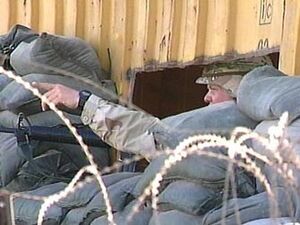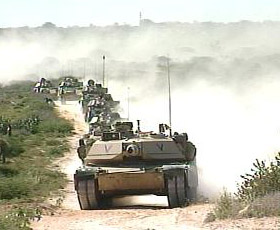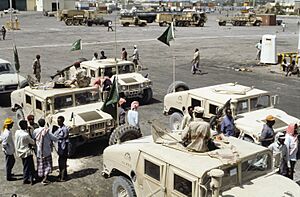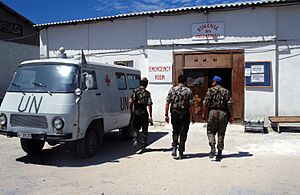United Nations Operation in Somalia II facts for kids
Quick facts for kids United Nations Operation in Somalia II |
|||||
|---|---|---|---|---|---|
| Part of the Somali Civil War | |||||
|
|||||
| Belligerents | |||||
|
United Somali Congress Somali National Alliance |
||||
| Commanders and leaders | |||||
|
|
|||||
| Strength | |||||
| 30,000 personnel, including 22,000 troops and 8,000 logistic and civilian staff | Unknown | ||||
| Casualties and losses | |||||
| 1,000+ killed, 3,000+ wounded, 22 captured | |||||
United Nations Operation in Somalia II (UNOSOM II) was the second major effort by the United Nations to help Somalia. It lasted from March 1993 to March 1995. Somalia was facing a serious civil war and a terrible famine at the time.
This mission followed an earlier UN effort, United Nations Operation in Somalia I (UNOSOM I), and a US-led force called the Unified Task Force (UNITAF). All these missions aimed to create a safe environment. This was needed so that aid workers could deliver food and help to people. Somalia had no strong central government, and different groups were fighting.
About four months into its mission, UNOSOM II became involved in heavy fighting. This was mainly against the Somali National Alliance, led by General Mohamed Farrah Aidid. A very famous and difficult battle, the Battle of Mogadishu, happened during UNOSOM II. This battle marked a turning point and led to the end of major international help in Somalia two years later.
Contents
Why Did UNOSOM II Start?
The first UN mission, UNOSOM I, did not succeed in making Somalia safe. So, the United States offered to lead a much larger force. The UN agreed to this plan. The United Nations Security Council Resolution 794 allowed this force to use "all necessary means" to create a safe environment for humanitarian aid.
On December 4, 1992, US President George H. W. Bush announced that US troops would go to Somalia. This US effort was called Operation Restore Hope. It joined a larger international force known as the Unified Task Force (UNITAF). The original UNOSOM I mission was paused.
The US planned for UNITAF to be a temporary mission. It had four main goals:
- First, deploy troops to secure ports and airports in Mogadishu. This city would be the main base.
- Second, expand the safe zone to nearby areas in southern Somalia. This happened faster than expected.
- Third, secure other key towns like Kismayo and Bardera. They also kept land routes safe for aid.
- Fourth, hand over control to the United Nations and pull out most US forces.
On March 3, 1993, the Secretary-General of the United Nations suggested that UNITAF should transition to UNOSOM II. He noted that Somalia was still not fully safe. There was no effective government or police force. He recommended that UNOSOM II should have strong powers to create a secure environment across all of Somalia. UNOSOM II would also help rebuild Somalia's economy, politics, and society.
The UN Security Council officially created UNOSOM II with United Nations Security Council Resolution 814 on March 26, 1993. It took over from UNITAF on May 4, 1993.
How UNOSOM II Operated
Somali leaders agreed to a new government system with 18 self-governing regions. UNOSOM II's goal was to support this new system and help rebuild the country. This included:
- Taking weapons from different fighting groups.
- Bringing back law and order.
- Helping Somalis create a representative government.
- Repairing important buildings and services.
UNOSOM II had about 28,000 people. This included 22,000 soldiers and 8,000 support staff. Many countries contributed troops, including Algeria, Australia, Bangladesh, Canada, Egypt, France, Germany, India, Italy, Malaysia, Pakistan, United Kingdom, and the United States. The US also provided a special Quick Reaction Force of 1,167 troops. These troops were on US Navy ships nearby. They would help UNOSOM II in emergencies if approved by US commanders.
Attacks and Conflicts in 1993
On June 5, 1993, a group of Pakistani soldiers went to check an arms depot. This depot belonged to Mohamed Farrah Aidid, a powerful Somali warlord. Angry Somali protesters met the Pakistani force. Twenty-four Pakistani soldiers were killed in an attack believed to be linked to Aidid's forces.
The UN quickly responded with United Nations Security Council Resolution 837. This resolution gave the UN permission to take "all necessary measures" against those responsible for the attacks. It also aimed to establish UNOSOM II's authority across Somalia. This was like declaring war on Aidid's militia.
Even though UNOSOM II had fewer resources for fighting than UNITAF, it became much more active and aggressive. On June 12, US troops started a military offensive around Mogadishu. On June 17, a reward of $25,000 was offered for information leading to Aidid's arrest. However, he was never caught.
The search for Aidid became a major focus of UNOSOM II. The increased military actions in Mogadishu led to civilian deaths. This made the relationship between foreign troops and the Somali people worse. UN troops were seen as outsiders, especially after incidents where civilians were harmed by gunfire.
The Abdi House Raid and More Fighting
On July 12, US helicopters attacked a house where clan elders were meeting. This event became known to Somalis as "Bloody Monday."
As the Americans became more isolated, warlords started to regain control of many parts of Mogadishu. With each failed attempt to capture Aidid, the militias grew bolder. Disagreements also grew among the countries contributing to UNOSOM II. Italy, for example, strongly criticized the American methods.
Task Force Ranger's Mission
Somali militias began to target peacekeepers, causing more casualties. On August 8, Aidid's militia used a remote-controlled bomb. It killed four American soldiers and injured seven more two weeks later. In response, US President Bill Clinton approved sending a special force. This force included 400 US Army Rangers and Delta Force Commandos.
This unit, called Task Force Ranger, had 160 elite US troops. They flew to Mogadishu to hunt for Aidid. On October 3, 1993, Task Force Ranger raided a hotel where they thought Aidid was hiding. This led to the longest and deadliest battle for US troops in Somalia.
In what became known as the Battle of Mogadishu, eighteen US soldiers were killed. Images of their bodies being dragged through the streets were shown on TV worldwide. This shocked and angered the American public.
End of UNOSOM II
After the Battle of Mogadishu, President Clinton announced on October 7, 1993, that the US would pull out all its forces by March 31, 1994. The UN Security Council, however, extended the UNOSOM mandate until March 1995.
US soldiers left Somalia on March 3, 1994, earlier than planned. Other Western nations, including Italy, Belgium, France, and Sweden, also decided to withdraw. On November 4, 1994, the UN Security Council voted to withdraw all remaining forces. This was because efforts to make peace by the 1,900 remaining UNOSOM II troops had failed. The final withdrawal of UN troops from Somalia was completed on March 28, 1995. This ended UNOSOM II's mission.
Various peace talks happened over the next few months. They aimed for a ceasefire, disarming militias, and creating a new government. However, these plans were often delayed, and many faction leaders ignored the agreements.
In December 1997, Somalia participated in talks in Cairo, Egypt. There, Aidid and another warlord, Mahdi, signed a "Declaration of Principles." This declaration promised new peace conferences and a plan for a temporary government.
Experts like Walter Clarke and Jeffrey Herbst noted that the intervention in Somalia was not a complete failure. They estimated that about 100,000 lives were saved. However, they also said that its problems should be a lesson for future peacekeeping missions.
UN Inquiry Findings
After the Battle of Mogadishu, the United States asked the United Nations to investigate. A three-person UN inquiry commission was set up. It recommended that Somali civilians who were harmed in the fighting should receive financial help.
The inquiry criticized the United States for operating its military actions separately from UNOSOM officers. It said these actions were not coordinated and did not fit with basic peacekeeping rules. It also criticized the use of American helicopters to fight in the crowded neighborhoods of Mogadishu.
Images for kids
See also
 In Spanish: Segunda Operación de las Naciones Unidas en Somalia para niños
In Spanish: Segunda Operación de las Naciones Unidas en Somalia para niños









